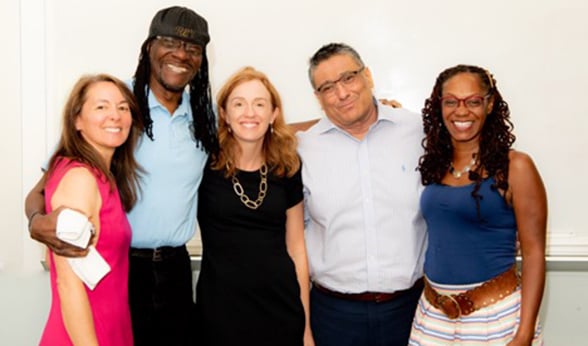Maisha Fields, nurse practitioner with the CU Anschutz student-run DAWN Clinic, will never forget her first patient in nursing school: a young man with a gunshot wound, the same age as her brother Javad when he was murdered along with his girlfriend 30 days after they graduated from college. It was the night before he planned to testify as a witness in an ongoing murder trial.
Fields recently joined fellow healthcare providers and community members for a panel discussion titled “Preventing gun violence: This is your lane”, hosted by the Department of Family Medicine at CU Anschutz. Panelists included Emmy Betz, MD, associate professor of Emergency Medicine; Rev. Leon Kelly, Jr., executive director for Open Door Youth Gang Options; and Kiki Leyba, Columbine High School teacher and shooting survivor.
Shale Wong, MD, MSPH, director of the Farley Health Policy Center and panel moderator, pointed out that 100 lives per day in the U.S. are lost due to gun violence. “This is a public health crisis,” she said.
Gun violence: one problem with many parts
Betz, an emergency physician at the CU Anschutz Medical Campus, framed the complexity of preventing gun violence by considering how to talk to patients. “The approach to preventing firearm injury or death with someone who’s depressed is a lot different than what you’ll say to a youth who’s afraid for their safety on the streets,” Betz said.
 |
| Panelists in the discussion are, from left: Shale Wong, director of the Farley Health Policy Center; Rev. Leon Kelly, Jr., executive director for Open Door Youth Gang Alternatives; Emmy Betz, associate professor in Emergency Medicine and co-founder of the Colorado Firearm Safety Coalition; Kiki Leyba, teacher and survivor of the Columbine High School shooting; and Maisha Fields, a political activist and nurse practitioner at the DAWN Clinic. |
Early in her career, Betz co-founded the Colorado Firearm Safety Coalition with Michael Victoroff, MD, a family physician and a licensed firearms instructor. The coalition, whose meetings are open to the public, has a shared goal of “educating firearm retailers, range employees, and the general public about suicide prevention and firearm safety.”
As an ER physician, Betz said most of the gun violence she sees is self-inflicted – i.e., suicide or suicide attempts. In Colorado, more than 75% of all gun deaths are due to suicide, significantly higher than the national firearm suicide rate of 50%. In her 2015 TEDx Mile High talk, Betz said firearm suicide attempts are the most deadly, and suicide death rates are particularly high among middle-aged and older white men.
A role for healthcare providers?
Now an experienced healthcare provider and political activist, Fields, FNP, practices one-on-one gun violence prevention. “As a clinician, I know that when I get a patient chart, sometimes I just want to look at the labs and the patient’s chief complaint.” But because healthcare providers are not taking sufficient time to read patient history and do interdisciplinary care, Fields said, “We are missing the boat for identifying at-risk patients.”
Fields said, “Each and every one of us has a responsibility to use our power and our voices to elevate what common-sense gun control looks like.”
Betz said providers need to approach challenging conversations about gun violence similar to the way they talk about HIV and substance abuse with patients. “I don’t think politics belong in the exam room. It’s not my job to tell patients how to live their lives or question their life, culture or background. It’s my job to educate in an evidence-based way.”
“It wasn’t just about Columbine”
Leyba was a first-year teacher at Columbine during the school shooting in 1999. In 2010, his middle child was standing outside at Deer Creek School in Littleton when a gunman opened fire on students. Leyba said, “That experience as an educator and parent has really colored my experience and my desire to do this work.”
Leyba began working with school communities in the aftermath of gun violence. Following Columbine, Leyba said he thought he was sufficiently coping with his own trauma. However, “I didn’t recognize the magnitude and the depth of the post-traumatic stress disorder symptoms I was experiencing.”
Leyba, still teaching at Columbine for over 20 years, credits counseling and self-care for saving his life. “It motivated me to take care of myself in ways I never used to. I wanted to prevent others from making the same mistakes I did.” Leyba said he realized it wasn’t enough to just work with victims in the aftermath of shootings. “I realized it wasn’t just about Columbine. I needed to get out front of what was happening,” prompting his involvement in activism and gun legislation advocacy.
‘Death List’: only a fraction of the violence
Rev. Kelly, Jr., executive director of Open Door Youth Gang Alternatives, held up a thick stack of paper. “I deal with a lot of death,” he said matter-of-factly. Kelly’s ‘Death List’, started in 1984 after Kelly’s first experience with a gang-related homicide, holds over 1,200 names of people of young people from the community who died a violent death.
Kelly noted that the names on the list represent only a fraction of the actual gun violence toll. “We don’t hear about a lot of the mass shootings over on my side of town,” he said.
According to Kelly, healthcare providers play a defined role in the war on gun violence. “You do your job, stitch up the troops, and send them back to the hood – that’s your lane in this war,” he said. Kelly added, “All of us on the panel – we are different messengers, but we have the same message.”
Wong, the moderator, concluded by acknowledging our individual roles and the impossibility of trying to address an issue as complex and painful as gun violence in only an hour. “Gun violence isn’t just one thing; loss of life isn’t just one story,” she said.
Guest contributor: Shawna Matthews, a CU Anschutz postdoc

.png)

